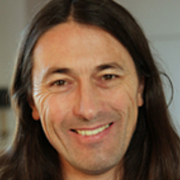
George Port
A film fan from an early age, George Port feasted on movies for free while growing up in the Hutt Valley — thanks to his grandfather running a shop adjoining the local cinema.
Later, while experimenting with computer animation at Victoria university, Port got some useful advice from local animator Euan Frizzell. Six months later, having animated some talking robots, Port was offered a job at Frizzell’s company Gnome Productions. Port worked on a variety of animation from stop motion to developing some basic computer animation systems.
During a quiet week at Gnome, Port heard about a puppet film being shot in a flat near Parliament. The film was for a self-funded television pilot called Meet the Feebles. The director was Peter Jackson. “When I turned up they handed me an elephant suit and said, ‘Here, put this on ... there wasn’t much on, so I just took a week off and went off to be a puppeteer.”
Port’s involvement in Jackson’s films would grow in league with the director’s burgeoning career. When Meet the Feebles was reborn as the director’s second feature film, Port was one of two people helping bring despicable Feebles' boss Bletch to life. On follow-up feature Braindead, he was one of the puppeteers helping create some of the film’s gore-soaked effects, and ended up cameoing on-screen as a party goer who loses his head. Port also shot a yet unseen video diary of the film’s making (as he had for Feebles).
Port had already made one short film of his own: 1989's Revenge of the Word Processors, in which future Shortland Streeter Michael Galvin battled gremlins conjured from inside a computer. Jackson’s producer Jim Booth now won funding for him to direct ambitious follow-up Valley of the Stereos. Near-wordless and loaded with special effects, the film chronicles an escalating pump-up-the-volume battle between a nature-loving hippy (Danny Mulheron) and his neighbour, noisy bogan (Murray Keane).
The CGI dinosaurs of Steven Spielberg’s Jurassic Park (1993) confirmed Port’s belief that computer animation was about to take over the world. Heavenly Creatures (1994) marked the turning point, where his interest in computer animation was first applied to feature films.
Port and Jackson joined others and leased a scanner, a recorder, and a Silicon Graphics computer; one of them had only just arrived on the market. But it was Port alone who was charged with trying to get them working together. One had only two pages of instructions. Port spent at least seven months working solo on Heavenly Creatures, from altering balconies to morphing landscapes into imaginary visions of paradise. Initially the new digital effects operation was grouped together with the physical effects of Richard Taylor and Tania Rodger, under the umbrella title Weta Ltd. Later Weta Ltd was split into two parts: Weta Digital, and Taylor's Weta Workshop.
Over the next two years Weta’s digital arm grew exponentially, upskilling on the run as it balanced fantasy Jack Brown Genius, parts of Forgotten Silver — for which George Port cameos on-screen as a pioneer aviator — forgotten Australian feature Napoleon, and Jackson’s first Hollywood-funded feature, the effects-heavy Frighteners.
Port then moved north to Auckland. While still at Weta he had worked with American production company Pacific Renaissance on its first forays down under. Now he began helping out on Xena and Hercules, for the shooting of scenes whose special effects were being handled in Hollywood. Port slowly began building up an Auckland-based effects team, and winning over Renaissance to the idea of taking on digital effects for their various New Zealand productions.
Port’s company PRPFX has gone on to provide effects for a run of TV series, feature films, music video and shorts (including the award-winning Cow) — plus Auckland Maritime Museum’s show Te Waka. The homegrown projects have seen Port’s team creating unusual flocks of sheep for Black Sheep, flying angels for The Vintner’s Luck, and dinosaurs for successful documentary The Lost Dinosaurs. They also supplied memorable shots of the hilltop Māori village in Vincent Ward’s Rain of the Children, and handled Port’s own short, adventure Egg and Bomb. (Port has also acted in a number of his own live action shorts).
PRPVFX partly owes its longevity partly to eight seasons plus of effects-heavy kidult series Power Rangers. Other American projects include work on the CGI costume for Green Lantern, TV series Legend of the Seeker, and forest fire mini-series Superfire (Port was one of those nominated for an Emmy). For 2005 comedy Racing Stripes (2005), the company created CGI mouths and lips so that the live action animals could speak.
Sources include
George Port
PRPVFX website. Accessed 21 January 2017
Ian Pryor, Peter Jackson - From prince of splatter to lord of the rings (Auckland: Random House New Zealand, 2003)